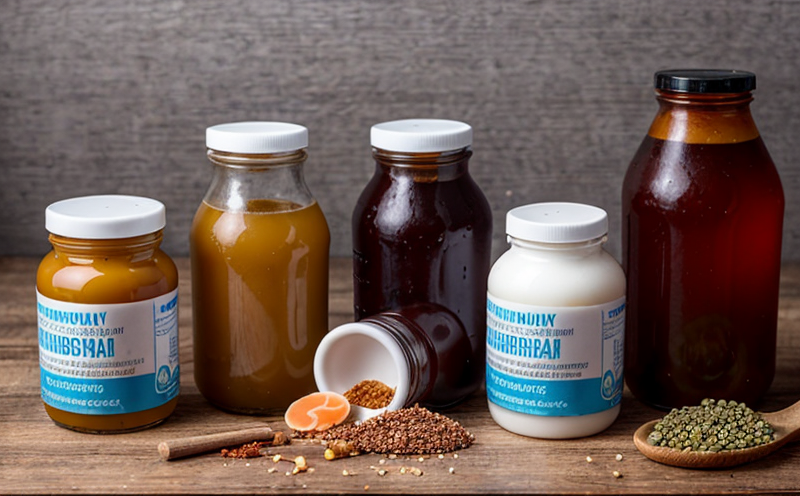USDA Pathogen Screening in Probiotic and Fermented Products
The United States Department of Agriculture (USDA) pathogen screening is a critical process that ensures the safety and quality of probiotic and fermented products. This testing procedure focuses on identifying potential pathogens such as Salmonella, Listeria monocytogenes, Escherichia coli O157:H7, and other harmful microorganisms.
Probiotic and fermented products are increasingly popular due to their perceived health benefits; however, they also present unique challenges in terms of microbiological safety. The presence of even small quantities of pathogens can lead to severe health risks for consumers, especially those with weakened immune systems. Therefore, regulatory bodies like the USDA mandate strict pathogen testing protocols to ensure the safety and efficacy of these products.
The process involves several key steps, including sample collection, homogenization, enrichment media incubation, selective isolation methods, and confirmatory tests using biochemical assays or PCR techniques. Compliance with international standards such as ISO 11133 and USDA guidelines ensures reliability and consistency in results.
For quality managers and compliance officers responsible for ensuring product safety, this test provides peace of mind by validating that products meet regulatory requirements. R&D engineers can use the results to optimize formulations while procurement teams ensure suppliers adhere to these stringent standards.
The significance of USDA pathogen screening cannot be overstated in today’s competitive market where consumer trust plays a crucial role in product acceptance and sales. By adhering to this rigorous testing protocol, manufacturers demonstrate their commitment to producing safe and high-quality probiotic and fermented products.
Why Choose This Test
Selecting USDA pathogen screening for your probiotic or fermented product is a strategic decision that underscores your dedication to consumer safety and regulatory compliance. Here are some compelling reasons why you should consider this test:
Regulatory Compliance: Meeting FDA and USDA standards enhances brand reputation and ensures legal compliance, which can protect against costly fines and product recalls.
Informed Decision Making: Reliable data from pathogen screening allows for informed decisions regarding ingredient sourcing, manufacturing processes, and storage conditions. This leads to improved product quality and reduced risks associated with microbial contamination.
Consumer Trust: Demonstrating adherence to stringent testing protocols builds trust among consumers who value transparency in food safety practices. This can positively impact brand loyalty and market share growth.
Competitive Advantage: In an increasingly competitive marketplace, standing out with a commitment to product safety sets your company apart from competitors. It positions you as a leader in quality assurance and ethical business practices.
Risk Management: Identifying potential hazards early through pathogen screening helps mitigate risks by implementing corrective actions before they escalate into major issues. This proactive approach reduces long-term costs associated with recalls or lawsuits.
International Acceptance and Recognition
The USDA pathogen screening is widely accepted internationally, providing a harmonized standard that facilitates trade across borders. Many countries recognize the USDA’s stringent guidelines as equivalent to their own national standards for microbiological safety.
For instance, the European Union (EU) accepts USDA results when they align with EU criteria for probiotics and fermented products. Similarly, Canada has adopted similar protocols, making it easier for exporters from the United States to comply with Canadian regulations.
The acceptance of USDA pathogen screening in international markets not only simplifies compliance but also opens up new opportunities for global expansion. Companies that achieve this certification demonstrate their commitment to meeting global standards, which is increasingly important as markets become more interconnected.
Moreover, the use of internationally recognized standards like ISO 11133 ensures consistency and comparability across different regions, reducing potential barriers to entry into foreign markets. This harmonization helps streamline operations for multinational corporations operating in various jurisdictions.
Use Cases and Application Examples
Table 1: Common Pathogens Targeted by USDA Screening
| Pathogen | Description |
|---|---|
| Salmonella | A genus of Gram-negative bacteria that can cause foodborne illness. |
| Listeria monocytogenes | An opportunistic pathogen capable of causing listeriosis, especially in vulnerable populations. |
| Escherichia coli O157:H7 | A strain known for its production of Shiga toxins and severe gastrointestinal symptoms. |
| Campylobacter jejuni | A zoonotic pathogen linked to waterborne diseases and improper food handling practices. |
Table 2: Example Products Undergoing Pathogen Screening
| Product Type | Description |
|---|---|
| Probiotic Supplements | Formulations containing live cultures intended to promote gut health. |
| Fermented Beverages | Beverages produced through fermentation processes, such as kombucha or kefir. |
| Soy Sauce | A traditional condiment made from fermented soybeans. |
| Yogurt | Rich in beneficial bacteria that support digestive health. |
The USDA pathogen screening is essential for ensuring the safety of various probiotic and fermented products. It helps identify potentially harmful microorganisms early in the production process, allowing manufacturers to take corrective actions promptly. This proactive approach ensures that only safe and high-quality products reach consumers.
For instance, a manufacturer producing a new line of kombucha may use pathogen screening to detect any contamination during fermentation or storage phases. Similarly, a company developing novel probiotic supplements might rely on this testing method to validate the safety profile before launching their product in the market.





